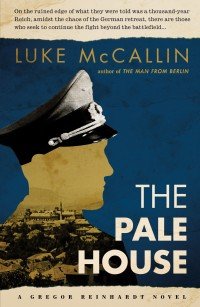It’s early spring, 1945, and the German army and its allies is being squeezed on all sides. British and American armies are pushing ever deeper into France, the Red Army is grinding closer towards Berlin, and in the Balkans, the Partisans are set to liberate the Bosnian capital of Sarajevo.
Hauptmann Gregor Reinhardt of the the Feldjaegerkorps (Wehrmacht military police) has returned to Sarajevo after a spell as a Gestapo captive, where he was suspected of treason. Reinhardt finds the city near chaos. The political and military situation is complex. The Croatian Ustase, nominally allies of the Germans, are becoming more and more bloodthirsty as they try to eliminate infiltration by the communist Partisans within the city. The main Partisan force is now only days from Sarajevo, and the Germans are doing their best to organise a disciplined and orderly retreat.
Reinhardt is called out to investigate a series of killings – massacres in all but name. He finds three survivors at one of the crime scenes – a young boy and an elderly married couple. When he takes them back into Sarajevo, he is reunited with Susana Vukic, the mother of the glamorous film maker whose death Reinhardt investigated in the first book of the series, The Man From Berlin. We reviewed that book in New Talent November 2014.
The mass killings have three things in common. First, the faces of the victims have been obliterated beyond recognition. Second, there seems to a definite connection to the Ustase, even though some of the victims were from that organisation. Third, and most troubling, is that the deaths seem to be linked to both the German Feldgendarmerie (a German military police of lower status than the Feldjaegerkorps) and a punishment battalion run by the Feldgendarmerie.
The Pale House of the title is a large property beside the river in Sarajevo which is the headquarters of the Ustase, but also a place where terrible beatings, torture and death are administered to those whom the Ustase suspect of being Partisan sympathisers. Reinhardt’s investigations lead him to The Pale House, and a terrifying thug known as Bunda. Deeper and more disturbing still are the suspicions that there is a web of corruption embedded deep in the higher ranks of the German command structure.
Like Philip Kerr’s Bernie Gunther novels, the first challenge facing McCallin is that he must establish that Reinhardt is a ‘Good German’. He does that with the simple tactic of revealing that Reinhardt is, in some way, implicated in the failed plot to assassinate Hitler, and also by drawing the distinction between men who were ‘simple’ soldiers in the Wehrmacht, as opposed to being in the Waffen SS or the Gestapo. Last year, as part of our New To November feature, we reviewed the first Gregor Reinhardt novel The Man From Berlin.
The overwhelming atmosphere of this superb book is one of great weariness. The soldiers of all sides are sleepless and racked with both physical and mental exhaustion. The food supplies in barracks are made up of iron rations, inedible bread and vile coffee. Sarajevo itself has, just about, survived another bitter Balkan winter, but one which has taken its toll. The portrait of a city on its knees, and coming apart at the seems, is painfully accurate.
Reinhardt has sufficient scope to exercise his detective skills, even amid the carnage of war, and this should please those readers who may be wondering if this is purely a historical novel. There is a brief but beautifully told love story embedded in the narrative, and fans of the books will be heartened at Luke McCallin‘s last words in The Pale House: “Although he may not serve under his country’s colours much longer, there is still much to fight for. Reinhardt will march again.”
Another excellent novel set in besieged Sarajevo is Dan Fesperman’s Lie in the Dark.
No Exit Press
Print/Kindle/iBook
£3.59
CFL Rating: 5 Stars
